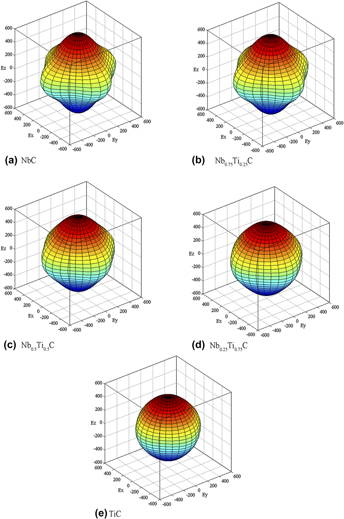Crossref Citations
This article has been cited by the following publications. This list is generated based on data provided by
Crossref.
Wang, Kaiming
Du, Dong
Chang, Baohua
Hong, Yuxiang
Ju, Jiang
Sun, Shuting
and
Fu, Hanguang
2018.
Mechanical Properties, Electronic Structures, and Debye Temperature of NixBy Compounds Obtained by the First Principles Calculations.
Crystals,
Vol. 8,
Issue. 12,
p.
451.
Hong, Dan
Zeng, Wei
Xin, Zhao
Liu, Fu-Sheng
Tang, Bin
and
Liu, Qi-Jun
2019.
First-principles calculations of structural, mechanical and electronic properties of TiNi-X (X=C, Si, Ge, Sn, Pb) alloys.
International Journal of Modern Physics B,
Vol. 33,
Issue. 16,
p.
1950167.
Sun, Shuting
Fu, Hanguang
Ping, Xuelong
Guo, Xingye
Lin, Jian
Lei, Yongping
Wu, Wenbo
and
Zhou, Jianxin
2019.
Effect of CeO2 addition on microstructure and mechanical properties of in-situ (Ti, Nb)C/Ni coating.
Surface and Coatings Technology,
Vol. 359,
Issue. ,
p.
300.
Hong, Dan
Zeng, Wei
Liu, Fu-Sheng
Tang, Bin
and
Liu, Qi-Jun
2019.
Structural, electronic, elastic and mechanical properties of NbC-based compounds: First-principles calculations.
Physica B: Condensed Matter,
Vol. 558,
Issue. ,
p.
100.
Pan, Yong
and
Jia, Yanlin
2019.
First-principles study of structure and mechanical properties of TMB12(TM = W and Ti) superhard material under pressure.
Journal of Materials Research,
Vol. 34,
Issue. 20,
p.
3554.
Sun, Shuting
Fu, Hanguang
Ping, Xuelong
Guo, Xingye
Lin, Jian
Lei, Yongping
Wu, Wenbo
and
Zhou, Jianxin
2019.
Formation mechanism and mechanical properties of titanium-doped NbC reinforced Ni-based composite coatings.
Applied Surface Science,
Vol. 476,
Issue. ,
p.
914.
Shuting, Sun
Hanguang, Fu
Ping, Xuelong
Guo, Xingye
Lin, Jian
Lei, Yongping
Wu, Wenbo
and
Zhou, Jianxin
2019.
Effect of liquid nitrogen cooling on grain growth and properties of laser cladding in-situ (Ti, Nb)C/Ni composite coatings.
Materials Characterization,
Vol. 152,
Issue. ,
p.
115.
Pan, Yong
and
Pu, Delin
2019.
Hydrogen embrittlement of C40 transition-metal disilicides.
Journal of Materials Research,
Vol. 34,
Issue. 18,
p.
3163.
Hong, Eunpyo
and
Lee, Heesoo
2020.
Microstructure, bonding state and phase formation behavior of carbon-doped TiZrN coating by laser carburization.
Surface and Coatings Technology,
Vol. 385,
Issue. ,
p.
125373.
Yang, Penghui
Fu, Hanguang
Guo, Xingye
Rachid, Bennacer
and
Lin, Jian
2020.
Mechanism of NbC as heterogeneous nucleus of M3C in CADI: first principle calculation and experiment research.
Journal of Materials Research and Technology,
Vol. 9,
Issue. 3,
p.
3109.
Zhang, Shuo-Xin
Liu, Shi-Yu
Yan, Da-Li
Yu, Qian
Ren, Hai-Tao
Yu, Bin
and
Li, De-Jun
2021.
First-principles study of structural stability and mechanical properties of Ta<sub>1–</sub><sub><i>x</i></sub>Hf<i><sub>x</sub></i>C and Ta<sub>1–</sub><sub><i>x</i></sub>Zr<i><sub>x</sub></i>C solid solutions.
Acta Physica Sinica,
Vol. 70,
Issue. 11,
p.
117102.
Peng, Junhui
and
Tikhonov, Evgenii
2021.
Improving the mechanical properties of HfC-based ceramics by exploring composition space of Hf1-Ta C and HfC1-N.
Computational Materials Science,
Vol. 195,
Issue. ,
p.
110464.
Ivashchenko, V.I.
Onoprienko, A.A.
Scrynskyy, P.L.
Kozak, A.O.
Shevchenko, V.I.
Tapajna, M.
Orovčík, L.
Lytvyn, P.M.
and
Medykh, N.R.
2022.
Structural, mechanical, optoelectronic and thermodynamic properties of bulk and film materials in Ti–Nb–C system: First-principles and experimental investigations.
Physica B: Condensed Matter,
Vol. 646,
Issue. ,
p.
414311.
Li, Chuanying
Fu, Tao
Hu, Hao
and
Peng, Xianghe
2022.
Mechanical properties and their sensitivity to point defects:
(HfNbTaTiZr)C
high-entropy carbide.
Physical Review B,
Vol. 105,
Issue. 22,
Wei, Lei
Yu, Jing
Yao, Lihua
and
Zhang, Lei
2022.
Effect of hydrostatic pressure on the mechanical, thermodynamic, and optical properties of orthorhombic WAlB.
Journal of Materials Research,
Vol. 37,
Issue. 23,
p.
4232.
Chen, Chao
Wang, Junfa
Ge, Yiyuan
and
Ma, Lili
2022.
Investigations on Microstructures and Properties of (Fe, Cr, W)7C3 Carbides by First Principles and Experiments.
Coatings,
Vol. 12,
Issue. 9,
p.
1363.
Yang, Changqiao
Liu, Xiangjun
Yang, Jichun
and
Yang, Quanhai
2022.
First-principles study on yttrium inclusions in micro alloyed steels.
Metallurgical Research & Technology,
Vol. 119,
Issue. 5,
p.
503.
Tang, C.
Guo, J.
Li, B.
Kostenevych, O.
Wang, L.
Rothwell, G.
and
Ren, J.
2022.
Advances in Manufacturing Processes, Intelligent Methods and Systems in Production Engineering.
Vol. 335,
Issue. ,
p.
71.
Faye, Omar
and
Szpunar, Jerzy A.
2024.
Effect of Metal Carbides on Hydrogen Embrittlement: A Density Functional Theory Study.
Hydrogen,
Vol. 5,
Issue. 1,
p.
137.






